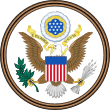History of the United States

When to date the start of the
history of the United States is debated among historians. Older textbooks start with the
arrival of Christopher Columbus
in 1492 and emphasize the European background, or they start in 1600
and emphasize the American frontier. In recent decades American schools
and universities typically have shifted back in time to include more on
the colonial period and much more on the prehistory of the
Native peoples.
[1][2]
Indigenous peoples lived in what is now the
United States for thousands of years and developed complex cultures before
European colonists began to arrive, mostly from England, after 1600. The Spanish had small settlements in
Florida and the
Southwest, and the French along the
Mississippi River and the
Gulf Coast. By the 1770s,
thirteen British colonies
contained two and a half million people along the Atlantic coast east
of the Appalachian Mountains. In the 1760s the British government
imposed a series of new taxes while rejecting the American argument that
any new taxes had to be approved by the people. Tax resistance,
especially the
Boston Tea Party (1774), led to punitive laws (the
Intolerable Acts)
by Parliament designed to end self-government in Massachusetts.
American Patriots (as they were called at the time as a term of
ridicule) adhered to a political ideology called
republicanism that emphasized civic duty, virtue, and opposition to corruption, fancy luxuries and aristocracy.
All thirteen colonies united in a Congress that called on the
colonies to write new state constitutions. After armed conflict began in
Massachusetts, Patriots drove the royal officials out of every colony
and assembled in mass meetings and conventions. Those Patriot
governments in the colonies unanimously empowered their delegates to
Congress to declare independence. In 1776, Congress created an
independent nation, the United States of America. With large-scale
military and financial support from France and military leadership by
General
George Washington, the American Patriots won the
Revolutionary War. The
peace treaty of 1783
gave the new nation the land east of the Mississippi River (except
Florida and Canada). The central government established by the
Articles of Confederation
proved ineffectual at providing stability, as it had no authority to
collect taxes and had no executive officer. Congress called a
convention to meet secretly in Philadelphia in 1787 to revise the Articles of Confederation. It wrote
a new Constitution, which was adopted in 1789. In 1791, a
Bill of Rights was added to guarantee
inalienable rights. With Washington as the Union's first
president and
Alexander Hamilton his chief political and financial adviser, a strong central government was created. When
Thomas Jefferson became president he purchased the
Louisiana Territory from France, doubling the size of the US. A second and last war with Britain was
fought in 1812.
Encouraged by the notion of
Manifest Destiny, federal territory expanded all the way to the Pacific. The expansion was driven by a quest for inexpensive land for
yeoman farmers and slave owners. The expansion of
slavery
was increasingly controversial and fueled political and constitutional
battles, which were resolved by compromises. Slavery was abolished in
all states
north of the
Mason–Dixon line by 1804, but the
South continued to profit off the institution, producing high-value cotton exports to feed increasing high demand in Europe. The
1860 presidential election of
Republican Abraham Lincoln
was on a platform of ending the expansion of slavery and putting it on a
path to extinction. Seven cotton-based deep South slave states seceded
and later founded the
Confederacy months before
Lincoln's inauguration. No nation ever recognized the Confederacy, but it opened the war by
attacking Fort Sumter in 1861. A surge of nationalist outrage in the North fueled a long, intense
American Civil War
(1861-1865). It was fought largely in the South as the overwhelming
material and manpower advantages of the North proved decisive in a long
war. The war's result was restoration of the Union, the impoverishment
of the South, and the abolition of slavery. In the
Reconstruction era (1863–1877), legal and voting rights were extended to the
freed slave. The national government emerged much stronger, and because of the
Fourteenth Amendment,
it gained the explicit duty to protect individual rights. However, when
white Democrats regained their power in the South during the 1870s,
often by paramilitary suppression of voting, they passed
Jim Crow laws to maintain
white supremacy, and new
disfranchising constitutions that prevented most
African Americans
and many poor whites from voting, a situation that continued for
decades until gains of the civil rights movement in the 1960s and
passage of federal legislation to enforce constitutional rights.
The United States became the world's leading industrial power at the
turn of the 20th century due to an outburst of entrepreneurship in the
Northeast and Midwest and the arrival of millions of immigrant workers
and farmers from Europe. The national railroad network was completed
with the work of
Chinese immigrants
and large-scale mining and factories industrialized the Northeast and
Midwest. Mass dissatisfaction with corruption, inefficiency and
traditional politics stimulated the
Progressive movement,
from the 1890s to 1920s, which led to many social and political
reforms. In 1920, the 19th Amendment to the Constitution guaranteed
women's suffrage
(right to vote). This followed the 16th and 17th amendments in 1913,
which established the first national income tax and direct election of
US senators to Congress. Initially neutral during
World War I, the US
declared war on Germany in 1917 and later funded the Allied victory the following year. After
a prosperous decade in the 1920s, the
Wall Street Crash of 1929 marked the onset of the decade-long world-wide
Great Depression.
Democratic President
Franklin D. Roosevelt ended the Republican dominance of the White House and implemented his
New Deal programs for relief, recovery, and reform. The
New Deal, which defined
modern American liberalism, included relief for the unemployed, support for farmers,
Social Security and a
minimum wage. After the
Japanese attack on Pearl Harbor on December 7, 1941, the United States later entered
World War II along with
Britain, the
Soviet Union, and the smaller
Allies. The U.S. financed the Allied war effort and helped defeat
Nazi Germany in
Europe and defeated
Imperial Japan in the
Pacific War by detonating newly invented
atomic bombs on enemy targets.
The United States and the Soviet Union emerged as rival superpowers after World War II. During the
Cold War, the US and the USSR confronted each other indirectly in the
arms race, the
Space Race,
proxy wars, and propaganda campaigns.
US foreign policy during the Cold War was built around the support of
Western Europe and
Japan along with the policy of "containment" or stopping the spread of
communism. The US joined the wars in
Korea and
Vietnam to try to stop its spread. In the 1960s, in large part due to the strength of the
civil rights movement,
another wave of social reforms were enacted by enforcing the
constitutional rights of voting and freedom of movement to
African-Americans and other racial minorities. Native American activism
also rose. The Cold War ended when the
Soviet Union officially dissolved
in 1991, leaving the United States as the world's only superpower. As
the 21st century began, international conflict centered around the
Middle East following the
September 11 attacks by
Al-Qaeda on the United States in 2001. In 2008, the United States had its
worst economic crisis since the Great Depression, which has been followed by slower than usual rates of economic growth during the 2010s.






